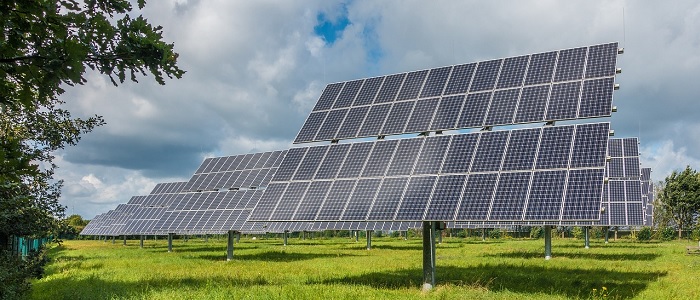Investing in the Renewable Energy Market

Understanding the Renewable Energy Investment Landscape
The shift towards the renewable energy market reflects a significant societal change in how we perceive energy production and consumption. As conversations around climate change and ecological sustainability grow louder, investors are recognizing the financial viability of sustainable energy sources. By prioritizing investments in renewable energy, not only do investors take a stand against environmental degradation, but they also tap into a sector with promising growth and robust returns.
Government Incentives: A Beneficial Boost
One of the most compelling reasons to invest in renewable energy is the array of government incentives available. In the UK, for instance, the government has introduced several initiatives aimed at reducing carbon emissions and promoting sustainability. Tax credits, grants, and feed-in tariffs help offset initial capital expenditures for projects such as solar installations or wind farms. Additionally, the Renewable Heat Incentive (RHI) provides financial incentives for using renewable heat technologies, which can make these investments much more attractive. Such support not only lowers the financial barriers for investors but also enhances the economic feasibility of renewable energy projects.
Technological Advancements: The Future is Now
Another factor driving the growth of the renewable energy market is the technological advancements that continue to enhance efficiency and reduce costs. Innovations in solar panel technology, for example, have led to significantly higher energy conversion rates and longer-lasting products. Wind energy has also benefited from improved turbine designs that capture more energy from lower wind speeds. These advancements not only improve the bottom line for investors but also accelerate the global transition towards cleaner energy. For instance, in recent years, the cost of onshore wind energy has decreased by nearly 50%, making it a highly competitive and attractive option for both utility-scale projects and individual investments.
The Rising Demand: A Market Opportunity
The demand for sustainable energy is not expected to wane anytime soon. In fact, the UK’s commitment to achieving net-zero emissions by 2050 has provided a clear market signal that clean energy solutions are the future. This burgeoning demand creates a landscape of market growth ripe with investment opportunities. Companies focused on renewable energy are expanding, and new players are entering the market daily. For investors, this means access to a diverse range of ventures—ranging from traditional energy corporations transitioning to greener practices to innovative startups creating cutting-edge technologies.
A Commitment to a Sustainable Future
Investing in renewable energy is about more than just financial returns; it’s also about making a commitment to a sustainable future. By funding these projects, investors play a critical role in combating climate change and encouraging responsible stewardship of the planet’s resources. This commitment resonates with consumers and businesses alike, as public support for sustainable practices continues to rise. Numerous studies show that companies with strong environmental practices often enjoy enhanced brand loyalty and customer engagement, thus indirectly benefiting their investors as well.
In conclusion, the renewable energy market presents a plethora of opportunities for investors willing to participate in this transformative sector. Understanding the incentives, technological advancements, and market demands can equip individuals and organizations with the knowledge to make informed decisions. As this landscape continues to evolve, the potential for impactful growth in renewable energy investments is substantial, awaiting those ready to engage with it.
Key Factors Influencing Renewable Energy Investments
As investors look to tap into the renewable energy sector, it is essential to understand the key factors that drive investment decisions in this rapidly evolving market. These elements not only impact profitability but also help identify which areas present the most promising opportunities. Here, we’ll explore some of these critical factors in more detail.
Market Trends: A Signals for Investors
Understanding current market trends is paramount for anyone considering investments in renewable energy. Recent trends indicate a marked shift towards decentralised energy systems, as consumers become more empowered and engage with renewable solutions like solar panels on residential rooftops. Market research shows that the UK solar market alone is expected to grow significantly, driven by both technological advancements and rising energy costs. This creates a unique investment opportunity as demand for solar technology rises among homeowners and businesses seeking to lower their energy bills.
Energy Storage Solutions: The Game Changer
Energy storage technologies are another crucial piece of the renewable energy puzzle. With the increased integration of intermittent renewable sources like solar and wind, the need for effective energy storage solutions becomes even more pressing. Technologies such as lithium-ion batteries and emerging alternatives are proving pivotal in allowing for the efficient storage and dispatch of renewable energy. As these systems become more affordable and widely adopted, investors can look to capitalise on companies involved in these innovative technologies, which are projected to revolutionise the energy landscape.
Environmental Regulations: Navigating Compliance
Staying abreast of environmental regulations is critical for investors. The UK government’s commitments to reducing carbon emissions significantly influences the renewable energy sector. Policies such as the Carbon Price Support mechanism and the commitment to phase out unabated coal-fired power generation by 2024 provide a regulatory framework that encourages investment in cleaner energy sources. Understanding these regulations can help investors identify sectors that offer strong growth potential while ensuring compliance with government mandates. Moreover, companies adhering to these regulations often gain a competitive edge, enhancing their attractiveness to investors.
Investment Diversification: Spreading Risk
One sound investment principle is diversification, and this holds particularly true in the renewable energy market. Investors can choose from a variety of sectors within the realm of renewables, including:
- Solar Energy: Investments in photovoltaic systems and large-scale solar farms.
- Wind Energy: Funding both onshore and offshore wind projects.
- Bioenergy: Support for projects converting waste into energy.
- Hydropower: Investments in generated power from water sources.
This diversification helps mitigate risks associated with any single investment while taking full advantage of the overall growth trend in renewable energy. By fostering a broad-based portfolio, investors can better navigate market fluctuations and uncertainties, allowing them to harvest the long-term benefits offered by the sector.
In conclusion, the decision to invest in the renewable energy market is influenced by a variety of critical factors including market trends, energy storage solutions, environmental regulations, and the importance of diversification. By carefully evaluating these facets, investors can make informed choices that align with their financial goals while supporting the transition to sustainable energy sources.
CHECK OUT: Click here to explore more
Understanding Risks and Opportunities in Renewable Energy Investment
While the potential for growth in the renewable energy market is significant, it is equally important for investors to grasp the risks and opportunities that exist within this sector. By understanding these dynamics, investors can make educated decisions and strategically position themselves for long-term success.
Technological Advancements: Keeping Pace with Innovation
Innovation is at the heart of the renewable energy sector. As technology evolves, new methods of generating, storing, and using energy emerge, creating investment opportunities for savvy investors. For example, advancements in solar panel efficiency, such as bifacial solar panels that capture sunlight on both sides, can significantly enhance returns on investment in solar farms. Moreover, the development of offshore wind technology, which harnesses more consistent wind patterns, offers compelling opportunities as the UK coastlines are geographically favourable for such projects. Staying informed about technological breakthroughs allows investors to pinpoint companies poised for growth and align their investment strategies accordingly.
Market Demand: An Increasing Shift Towards Sustainability
The global demand for renewable energy sources continues to rise, driven both by increased consumer awareness and the pressures of climate change. A recent survey indicated that over three-quarters of UK adults are concerned about climate change and support a transition to renewable energy. This growing consumer demand leads to greater investments, as companies pivot towards more sustainable practices to meet the expectations of both consumers and government regulations. By targeting companies that are responsive to this increasing market demand, investors can capitalise on a sector that is not only profitable but also aligned with societal goals, promoting a cleaner environment.
Financial Incentives: Government Support for Renewable Projects
The UK government has introduced a variety of financial incentives aimed at encouraging investments in renewable energy. Schemes such as the Feed-in Tariff (FiT) and the Contracts for Difference (CfD) provide guaranteed payments for electricity generated from renewable sources, thus reducing investment risks. Understanding these schemes allows investors to better gauge the financial viability of potential projects. Additionally, tax relief incentives for renewable energy investments further sweeten the deal, making the prospect of entering this market even more attractive.
Global Competition: Navigating the International Landscape
The renewable energy market is not confined to the UK; it operates on a global scale. As such, global competition plays a crucial role in shaping investment landscapes. For instance, countries like Germany and China have become leaders in renewables, setting benchmarks in technology and driving down costs. By learning from these international models, UK investors can identify emerging trends, forecast market shifts, and maybe even consider collaboration or investment in foreign companies that show promising growth potential. This broadened perspective allows investors to make informed decisions, leveraging global knowledge to anticipate domestic market movements.
Long-term Vision: Commitment to Sustainability
Investment in renewable energy is fundamentally intertwined with a long-term vision for sustainability. Investors must recognise that the true value of renewable energy projects often extends beyond immediate profits. By embracing a long-term perspective, investors can align their portfolios with their values and contribute to a sustainable future. This perspective encourages patience and the understanding that, while short-term fluctuations may occur, the upward trajectory of renewable energy remains strong as the world transitions towards cleaner energy sources.
Navigating the landscape of renewable energy investments requires a comprehensive understanding of risks and opportunities, technological advancements, market demand, financial incentives, global competition, and a long-term vision for sustainability. With this knowledge, investors are better equipped to make informed decisions that not only foster financial success but also advance the global aim of transitioning towards environmentally-friendly energy solutions.
SEE ALSO: Click here to read another article
Conclusion: Embracing the Future of Energy Investment
Investing in the renewable energy market presents a compelling opportunity for individuals and institutions alike. As we’ve explored, the combination of technological advancements, growing market demand, and supportive government initiatives creates a dynamic environment ripe for investment. The global movement towards sustainability is not merely a trend; it is a fundamental shift in how we produce and consume energy, underscored by escalating concerns regarding climate change and environmental degradation.
Moreover, understanding the risks inherent in this sector, alongside a strategic approach to navigating global competition, empowers investors to make informed choices. By aligning investments with long-term sustainability goals, individuals can not only anticipate financial returns but also contribute to a cleaner and greener future. For example, supporting companies that are pioneering renewable technologies or investing in sustainable infrastructure projects can yield both ecological and economic benefits.
As we look to the future, it’s crucial for investors to maintain a flexible and informed approach. Market trends may shift, technologies will continue to innovate, and policies will evolve, but the core principle remains the same: investing in renewable energy is a step toward a sustainable and prosperous future. By embracing this transformative movement, investors can play a crucial role in shaping a resilient economy while building wealth that aligns with their values. Ultimately, the renewable energy market is not just an investment in financial returns; it is an investment in the future of our planet.

Linda Carter is a writer and financial consultant specializing in economics, personal finance, and investment strategies. With years of experience helping individuals and businesses make complex financial decisions, Linda provides practical analyses and guidance on the World Information Now platform. Her goal is to empower readers with the knowledge needed to achieve financial success.





